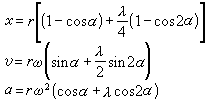1) kinetics of particle aggregation


颗粒凝聚动力学
2) particle dynamics


颗粒动力学
1.
To probe into the effects of the interaction of fluid mechanics and particle dynamics in the process of flame synthesis, the simulation of titania nanoparticle synthesis in the turbulent diffusion flame was performed by using the commercial CFD-code FLUENT.
为了解火焰法合成纳米颗粒过程中流体力学和颗粒动力学作用过程,利用CFD商业软件FLUENT模拟了在湍流扩散火焰中合成TiO2纳米颗粒的过程。
2.
Based on particle dynamics, numerical simulations were conducted to study the three-dimensional (3-D) microstructures of the ferro-fluids subjected to rotating magnetic fields.
使用颗粒动力学模型,通过对在旋转磁场条件下铁磁流体的数值模拟,得到了铁磁流体的三维结构。
3.
1d)and its soluble parent, 238U, was used to study the particle dynamics at three stations in the northeastern South China Sea.
利用234Th-238U不平衡研究南海东北部海域3个站位上层水体中的颗粒动力学性质,测定了水往中溶解态及颗粒态234Th的比活度,具体讨论各相中234Th/238U)AR(放射性活度比)比值的垂直分布情况及其与水化学要素间的关系。
3) kinetic theory of granular flow


颗粒动力学
1.
The model,based on the kinetic theory of granular flow which recently is widely used to describe particle flow and simulates both gas phase and solid phase by low Reynolds number turbulent model taking into account the turbulent interaction between gas and particles.
模型用颗粒动力学理论描述颗粒与颗粒间的碰撞 ,用低Reynolds数湍流方程分别模拟气相和颗粒相的湍动 ,并且考虑了气固两相湍动的相互作用 。
2.
The kinetic theory of granular flow was used to predict the particle fluctuating properties and the sub-grid scale model (SGS) for gas turbulent flow.
基于气固两相双流体模型和颗粒动力学方法模拟流化床内气体和颗粒流动特性,采用单层能量耗散磨损模型模拟沉浸管的磨损率和亚网格尺度模型(SGS)模拟气相湍流流动,同时应用贴体坐标系使计算网格与沉浸管表面相吻合。
4) kinetic theory of granular


颗粒动力学
1.
The gas-phase and granular-phase velocity distribution and pressure loss were obtained through the numerical simulation of the upwards flow characteristics in the vertical pipe by using an Euler-Euler two fluid model of dense gas-solid two phase flow based on the kinetic theory of dense gases and kinetic theory of granular.
基于稠密气体分子运动论和颗粒动力学,应用稠密气固两相流动的欧拉-欧拉双流体数学模型,利用数值方法模拟模拟垂直管内上升流动的行为,得到了气相和颗粒相速度分布以及压力损失。
5) coalescence kinetics


凝聚动力学
1.
Method: The electricity,rheology and coalescence kinetics of oral harmine emulsion were determined by electrophoresis, viscometry and conductometry respectively.
方法 :分别采用界面电泳法、旋转式粘度计、电导法等方法 ,测定口服乳剂的电学、流变学、凝聚动力学等物理性质。
6) dissipative particle dynamics


耗散颗粒动力学
补充资料:动力机械:内燃机动力学
研究内燃机运转中的力学现象的科学。其主要任务是研究分析内燃机运转时各主要零件的运动规律及其受力情况﹐用以作为内燃机零件设计﹑计算的依据。它还研究这些力对内燃机动力装置的影响及其消减方法。内燃机动力学的主要内容为曲柄连杆机构运动学﹑曲柄连杆机构动力学和内燃机平衡分析等。
曲柄连杆机构运动学 研究曲柄﹑连杆﹐尤其是活塞的运动规律。活塞作周期性往复运动时的位移 、速度
、速度 和加速度
和加速度 可用下述各式近似求算
可用下述各式近似求算

式中 为曲轴转角﹔
为曲轴转角﹔  为曲轴旋转角速度﹔
为曲轴旋转角速度﹔ 为曲柄半径﹔
为曲柄半径﹔ 为曲柄半径
为曲柄半径 与连杆长度
与连杆长度 之比﹐即
之比﹐即  =
=  /
/ 
曲柄作回转运动﹐连杆作复杂的平面运动。连杆的运动往往被简化分解为随活塞组的往复运动和随同曲柄的旋转运动。
曲柄连杆机构动力学 研究分析曲柄连杆机构(见曲柄滑块机构)在运动中力的生成﹑传递和输出。作用在曲柄连杆机构上的力有曲柄连杆机构运动时产生的往复惯性力和离心惯性力﹐以及内燃机气缸内的气体压力。
说明:补充资料仅用于学习参考,请勿用于其它任何用途。
参考词条